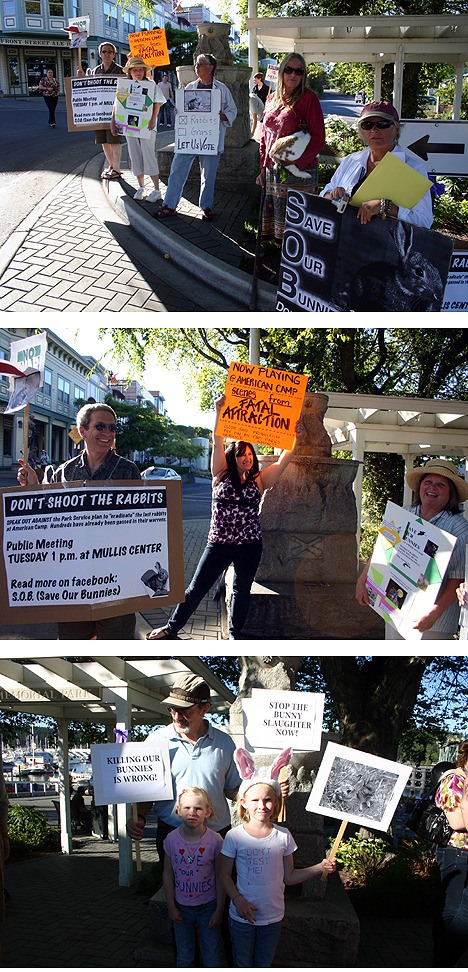The ideas flowed as freely as the words of protest to save the American Camp rabbits: Find the rabbits new homes. Relocate them to animal sanctuaries. Let them remain on the prairie and fence off an area where native grasses can flourish without rabbit interference.
All were unanimous: The American Camp rabbits should live.
About 25 sign-toting islanders protested Friday afternoon at Memorial Park, timed for the arrival of the 6:10 ferry from Anacortes. They encouraged motorists and pedestrians to attend the public meeting July 27, 1 p.m. at Mullis Center on the National Park Service’s plan to remove the rabbits from the American Camp prairie, as part of its prairie restoration plan.
And they encouraged them to honk if they love bunnies.
Some protesters wore rabbit ears. One islander carried her pet rabbit, which she said is part Angora and part “San Juan Island rabbit.”
Katie Gauthier, 18, of Friday Harbor raised chickens and rabbits as a 4-H’er. She said that if the rabbits have to be removed from the prairie, they should be relocated to homes or sanctuaries.
Vicki Griebling didn’t see any difference between rabbits burrowing for warrens and humans burrowing for utilities, like sewer lines.
“It’s all right for humans to utilize and even damage their natural environment but not rabbits, which are also mammals,” she asked. “How can a rabbit damage wildlife or wildlife habitat when it is wildlife? There are also people that are considered pests that we tolerate.”
Griebling suggested that American Camp doesn’t have to be entirely devoted to the island’s military history; she suggested that the National Park fence off an area where native grasses can grow and people can learn about the native habitat of the area from the mid-1800s.
“How can you justify killing a more complex animal species for a simply plant grass?”
Artist Bryn Barnard of Friday Harbor believes the impacts of removing the rabbits from the prairie have to be further studied – if the rabbits are removed, what happens to the foxes and the eagles? Although the rabbits and foxes were introduced to the island, “an ecosystem has been crated there. If you remove the rabbits, you destabilize the ecosystem.”
He also believes the analysis should be “transparent.” “There isn’t the rabbit population there used to be. How did the population drop? And what’s going to happen now?”
The National Park Service released for public comment July 8 an environmental assessment that proposes to control the population of non-native European rabbits at San Juan Island National Historical Park’s American Camp.
Shooting is considered one of the most effective techniques for rabbit removal and is the primary method recommended in the feasibility study conducted for the park in 2006 by Island Conservation, a non-profit that specializes in removing invasive species from islands.
The plan is one big step in the restoration of the prairie, which is home to numerous native plant and animal species, some of them sensitive or endangered. Park Superintendent Peter Dederich said restoration of the prairie will take about 50 years.
“The goal is to eliminate European rabbits from and prevent their recolonization in the park, which will allow us to protect important natural and cultural resources threatened by this non-native species,” Dederich said in a press release. “It also will afford us the opportunity to mitigate past damage caused by the rabbits.”
A formal 30-day public review and comment period for the environmental assessment is from July 8 to Aug. 12. A public meeting is scheduled from July 27, 1-3 p.m., at Mullis Community Senior Center in Friday Harbor.
European rabbits were introduced to the island between 1875 and 1895, presumably as a food source. Not surprisingly, their population spread quickly. They were hunted in the mid-20th century; The Oaks neighborhood is located on the site of a former rabbit-hunting camp. Rabbit hunting on San Juan Island was the subject of a feature story in the Sept. 28, 1964 edition of Sports Illustrated.
To many islanders and visitors, the rabbits became part of local lore as well as the local landscape. But to farmers and preservationists, the rabbits became a pest. According to the National Park, the rabbits — through their burrowing and their diet — destroy wildlife habitat, damage native plant communities, and confound efforts to restore native species. Their burrowing also damages important cultural resources and displaces artifacts the park was established to protect, park officials say.
More than 470 non-native rabbits inhabit about 150 acres of American Camp today, down from an estimated high of 50 rabbits per acre in the 1970s and about 23 rabbits per acre in 2005, Dederich said.
In addition to the public meeting, public comments can be mailed to Superintendent, San Juan Island NHP, P.O. Box 429, Friday Harbor, WA 98250.



